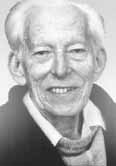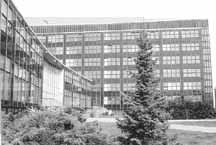
Chemistry International
Vol. 22, No.2, March 2000
2000, Vol. 22
No. 2 (March)
..News from IUPAC
..West Africa Chemical Society
..Reports from Symposia
..Awards and Prizes
..New Books
..Reports from Commissions
..Conference Announcements
..Conferences
Download the March
issue in pdf format.
(397K)
Download the March
cover in pdf format.
(246K)
Chemistry International
Vol. 22, No. 2
March 2000Reports from IUPAC-Sponsored Symposia
12-15 July 1999,
Prague, Czech RepublicThis symposium was chaired by Dr. Petr Vlcek and organized by the Institute of Macromolecular Chemistry, Academy of Sciences of the Czech Republic, one of the most prestigious research institutions in Europe and the organizer of a series of IUPAC microsymposia and discussion conferences within a program called "Prague Meetings on Macromolecules". On average, two microsymposia and one discussion conference per year are organized.
The Institute of Macromolecular Chemistry in Prague, with its former directors, the late Prof. Otto Wichterle and long-time IUPAC member Prof. Pavel Kratochvil, is now headed by a new director from a younger generation, Dr. Karel Ulbrich. The directors and their staff organize these meetings to deal with problems related to the research carried out at the Institute. Meetings are attended by distinguished scientists from all over the world. Virtually all leading researchers in macromolecular science have attended at least oneóor more often severalóof these meetings. The research program of the Institute is sufficiently diversified to encompass the major contemporary topics of these symposia.
Prof. Otto Wichterle
Former Director
Institute of Macromolecular ChemistryInstitute Director Ulbrich opened the symposium with his presentation, and Prof. Stanislaw Penczek, Official IUPAC Representative, gave a congratulatory speech on behalf of Prof. Joshua Jortner, President of IUPAC, and Prof. Robert Gilbert, President of the Macromolecular Division of IUPAC.
The Institute of Macromolecular ChemistryThe symposium attracted 127 active participants from 29 countries, including 25 from the Czech Republic. There were 9 main lectures, 23 special lectures, and 61 posters. Main lectures were presented on both radical and ionic polymerization, as follows:
K. Matyjaszewski (United States)."Atom transfer radical polymerization as a route to polymers with controlled architecture, compositions, and functionality".
M. Sawamoto and M. Kamigaito (Japan)."Controlled synthesis of functionalized polymers by transition metal-mediated living radical polymerization".
Y. Yagci (Turkey)."Photoinitiating systems and their use in polymer synthesis".
R. P. Quirk (United States)."Anionic synthesis of functionalized polymers using functionalized initiators and electrophilic termination reactions".
N. Hadjichristidis (Greece)."Synthesis and characterization of model 4-sulfozwitterionic polymers of variable architecture".
A. Hirao (Japan)."Anionic living polymerizations of functional monomers. Precise synthesis of various polystyrenes with monosaccharide residues by means of anionic living polymerization and living functionalization reaction".
S. Penczek and A. Duda (Poland)."Polymerization of cyclic esters on covalent metal alkoxides and carboxylates. Importance for polymer synthesis".
A. H. E. Müller (Germany)."New well-defined polymer structures via living polymerizations".
P. J. Lutz (France)."Control of macromolecular architectures via various polymerization processes: Advantage and drawback".
Although any choice of the other lectures would be strictly personal, I should note that interest is focused on radical polymerization allowing several kinetic and structural features of resulting polymers to be controlled. Thus, mostly nitroxy-mediated polymerization and atom transfer radical polymerization (ATRP) were discussed. These forms of polymerization are not as demanding from the experimental viewpoint as ionic processes, and it was shown that they may lead to graft, block, multiblock, star, and functionalized macromolecules from several classes of monomers. In these processes, termination by macroradical coupling or disproportionation cannot be avoided, but macromolecules of medium molar masses (e.g., up to l04 and sometimes higher) can be prepared with well-controlled molar masses and end-groups. By"controlled", it is understood that, e.g., almost 100% of the end-groups have the desired structure. Control of molar masses means that within a certain range of molar masses, one can obtain a desired and planned molar mass.
The main lectures were given by well-seasoned scientists, although the younger rising stars, such as Profs. Müller, Lutz, and Matyjaszewski, were also present.
In special lectures, both ionic and radical techniques were exposed. Polymers with special properties, further developments in heteromultistar polymers, water-soluble polymers, and molecular recognition in template polymerization were considered the most interesting directions for research.
In addition to the scientific program, the organizers provided social events and a program for accompanying persons that included sightseeing in Prague and a guided tour of the Old Town with a walk over famous gothic Charles Bridge, a visit to the Prague Castle Hradcany, and dinner at the house where Mozart wrote Don Giovanni.
All of us have been convinced that we participated not only in a first-class scientific meeting, but also spent a few happy days in the most beautiful town of Central Europe.
Professor Stanislaw Penczek
Titular Member, Macromolecular Division (IV) Committee
Associate Member, Commission on Macromolecular Nomenclature (IV.1)
Lódz, Poland
News
and Notices - Organizations and People
- Standing Committees
Divisions
- Projects - Reports
- Publications - Symposia
- AMP - Links
Page last modified 14 February 2000.
Copyright © 1997-2000 International Union of Pure and Applied Chemistry.
Questions or comments about IUPAC, please
contact the Secretariat.
Questions regarding the website, please contact [email protected]


